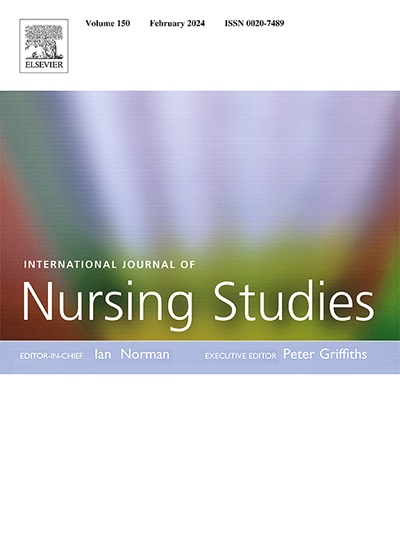Digital exclusion in older adults: A scoping review
IF 7.1
1区 医学
Q1 NURSING
引用次数: 0
Abstract
Background
The intersection of aging and digitalization is a distinctive feature of this new era. While digitalization brings convenience, it also forces older people to use tools that did not exist during their formative or working years. Understanding digital exclusion in older adults, the primary demographic affected, is essential to better support integration into the digital society, particularly in enhancing digital healthcare services' usability, continuity, and precision.
Objective
This study aims to conduct a scoping review of digital exclusion to better understand its current state in older adults.
Methods
The scoping review followed a five-stage framework and the PRISMA-ScR checklist statement. We systematically searched PubMed, CINAHL Plus with Full Text, Academic Search Complete, ACM digital library, Web of Science, and ProQuest from the earliest available date to May 2024.
Results
A total of 39 articles were included in the scoping review. The attributes of digital exclusion were identified as resource exclusion, skills exclusion, and motivational exclusion. Contributing factors were categorized into three domains: sociodemographic characteristics, physiological conditions, and psychological states. The consequences of digital exclusion were separated into social exclusion and technology anxiety. Intervention strategies included accessibility, ability, and willingness, aligning with the attributes of digital exclusion in older adults.
Conclusions
The findings of this scoping review contribute to understanding and clarifying digital exclusion in older adults. Digital exclusion is a prevalent, complex, multi-causal, and multidimensional phenomenon that predisposes individuals to social exclusion. Identifying attributes, contributing factors, and consequences can guide digital product developers, sociologists, and geriatric clinicians in addressing digital exclusion in older adults to improve their mental and physical well-being. Future research should focus more on empirical studies to deepen our understanding of digital exclusion in older adults.
Tweetable abstract: The definition of digital exclusion is inconsistent. Further clarification of contributing factors, developing measurement tools, and formulating interventions for digital exclusion in older adults can contribute to achieving consensus on the concept.
老年人的数字排斥:一项范围审查
老龄化与数字化的交汇是新时代的鲜明特征。虽然数字化带来了便利,但它也迫使老年人使用在他们成长或工作期间不存在的工具。了解老年人(受影响的主要人群)的数字排斥现象,对于更好地支持融入数字社会,特别是在提高数字医疗保健服务的可用性、连续性和准确性方面,至关重要。目的本研究旨在对数字排斥进行范围审查,以更好地了解其在老年人中的现状。方法采用五阶段框架和PRISMA-ScR检查表进行范围审查。我们系统地检索了PubMed、CINAHL Plus全文、Academic Search Complete、ACM数字图书馆、Web of Science和ProQuest,检索时间最早到2024年5月。结果共纳入39篇文献。数字排斥的属性被确定为资源排斥、技能排斥和动机排斥。影响因素分为三个方面:社会人口特征、生理条件和心理状态。数字排斥的后果分为社会排斥和技术焦虑。干预策略包括可及性、能力和意愿,与老年人数字排斥的属性一致。结论本综述的发现有助于理解和澄清老年人的数字排斥。数字排斥是一种普遍的、复杂的、多原因的、多维的现象,它使个人容易受到社会排斥。识别属性、影响因素和后果可以指导数字产品开发人员、社会学家和老年临床医生解决老年人的数字排斥问题,以改善他们的身心健康。未来的研究应更多地侧重于实证研究,以加深我们对老年人数字排斥的理解。摘要:数字排斥的定义不一致。进一步澄清影响因素,开发测量工具,制定针对老年人数字排斥的干预措施,有助于就这一概念达成共识。
本文章由计算机程序翻译,如有差异,请以英文原文为准。
求助全文
约1分钟内获得全文
求助全文
来源期刊
CiteScore
15.00
自引率
2.50%
发文量
181
审稿时长
21 days
期刊介绍:
The International Journal of Nursing Studies (IJNS) is a highly respected journal that has been publishing original peer-reviewed articles since 1963. It provides a forum for original research and scholarship about health care delivery, organisation, management, workforce, policy, and research methods relevant to nursing, midwifery, and other health related professions. The journal aims to support evidence informed policy and practice by publishing research, systematic and other scholarly reviews, critical discussion, and commentary of the highest standard. The IJNS is indexed in major databases including PubMed, Medline, Thomson Reuters - Science Citation Index, Scopus, Thomson Reuters - Social Science Citation Index, CINAHL, and the BNI (British Nursing Index).

 求助内容:
求助内容: 应助结果提醒方式:
应助结果提醒方式:


